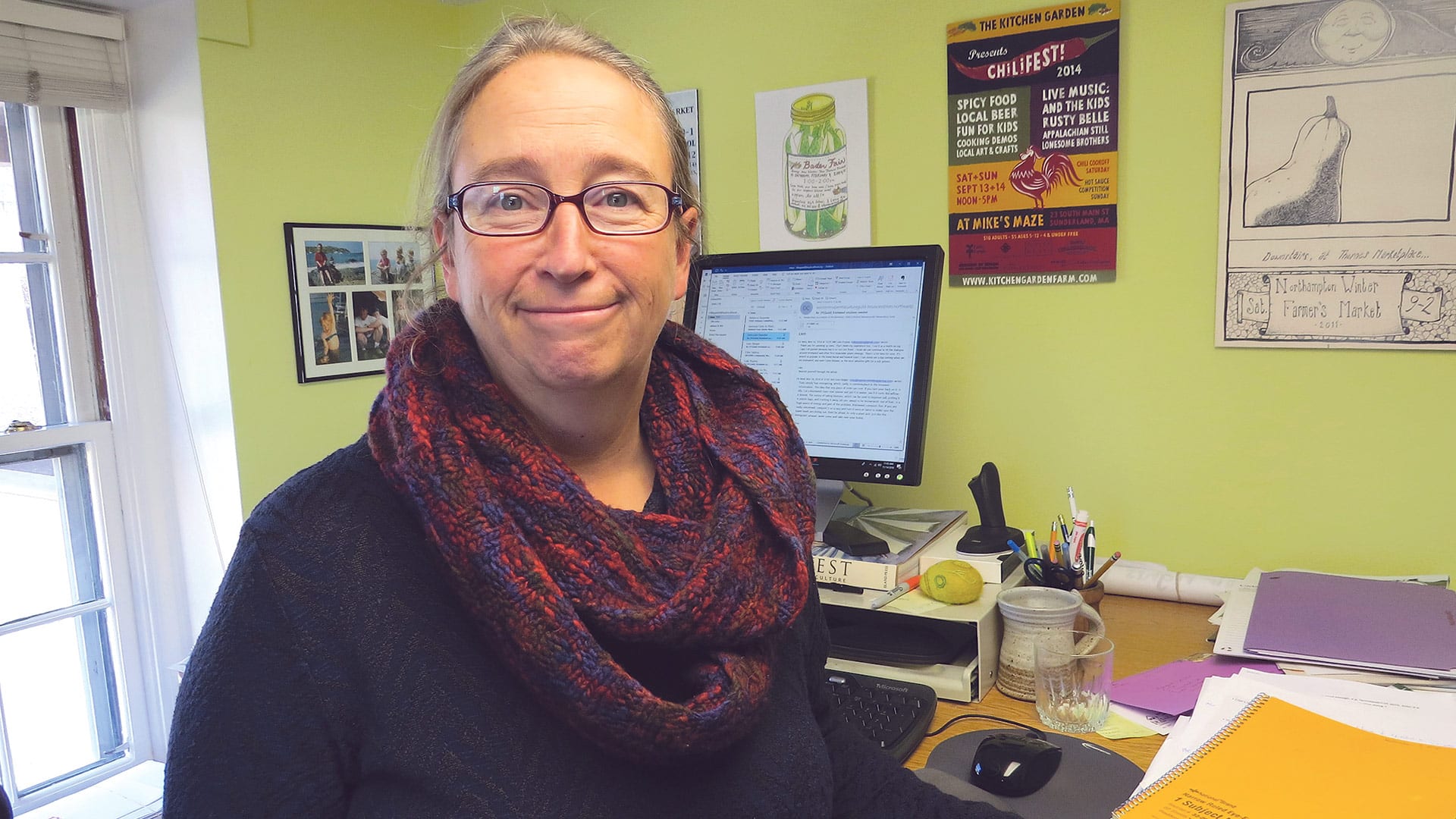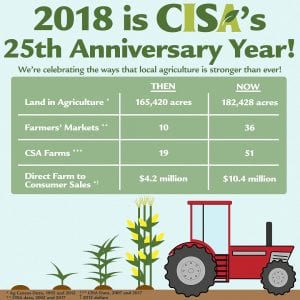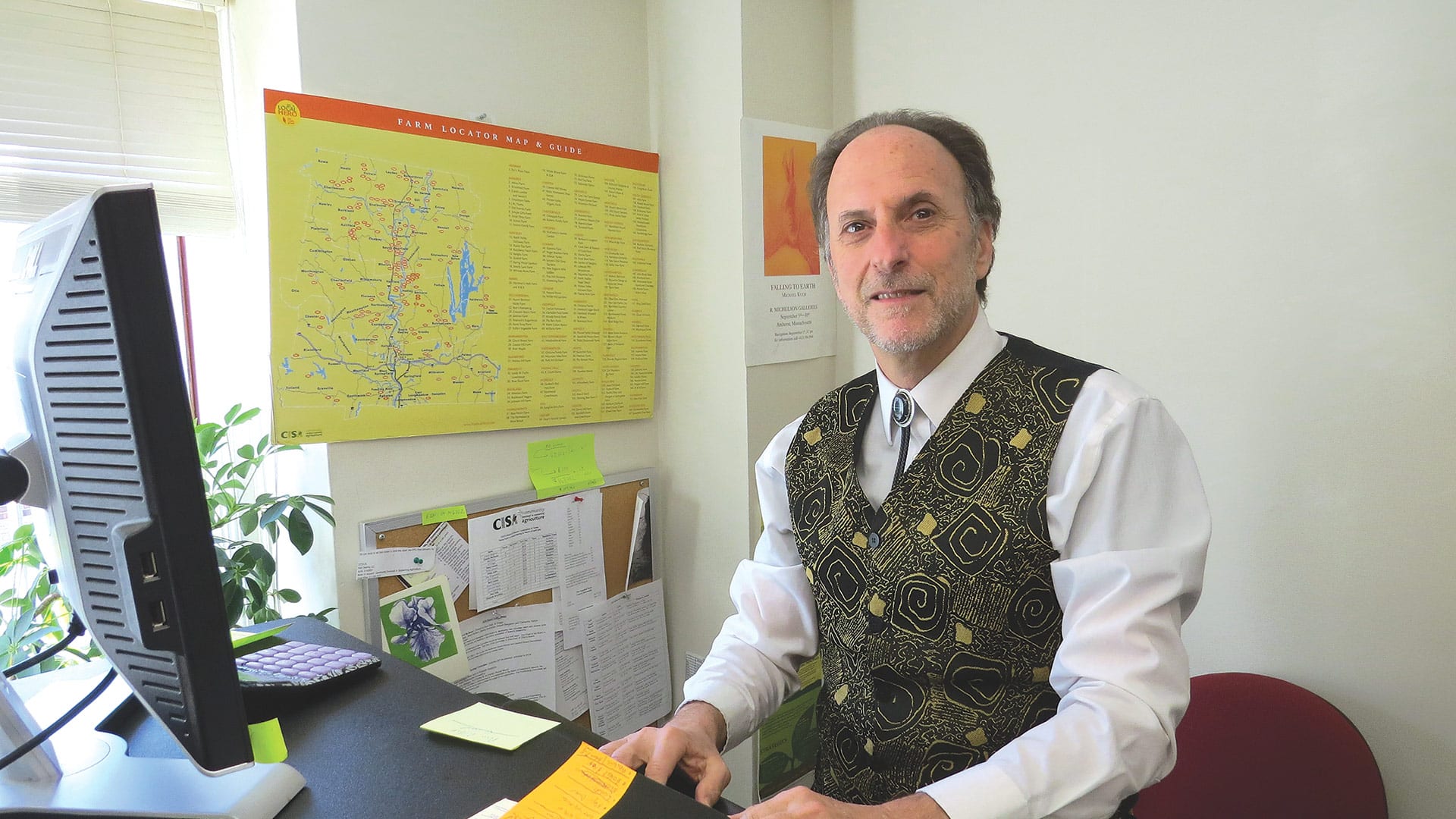
CISA Celebrates 25 Years of Sustaining Local Agriculture
Supporting a Growth Industry
 When CISA (Community Involved in Sustaining Agriculture) was launched 25 years ago, this region’s agricultural community was threatened by a host of issues and societal changes. Today, those challenges remain, but CISA, through its ‘buy local’ program and other initiatives, has lived up to its name by getting the community involved in sustaining and growing this vital sector of the economy.
When CISA (Community Involved in Sustaining Agriculture) was launched 25 years ago, this region’s agricultural community was threatened by a host of issues and societal changes. Today, those challenges remain, but CISA, through its ‘buy local’ program and other initiatives, has lived up to its name by getting the community involved in sustaining and growing this vital sector of the economy.
Margaret Christie is quick to point out that the many challenges area farmers faced a quarter century ago are still as much a part of the landscape as asparagus fields in Hadley.
These include everything from the cost of land (among the highest levels in the country), to the many pressures on that land, meaning attractive development options ranging from housing subdivisions to industrial parks, to immense competition from across the country and around the world.
And there are even some additional challenges, including an aging group of farm owners and workers — Baby Boomers are hitting retirement age — and a phrase you didn’t hear much, if at all, in 1993, but certainly heard this summer as the rain kept coming down in the 413: Climate change.
But the environment for farmers has been altered in one important respect, said Christie, and that comes in the form of an additional and quite significant support system called, appropriately enough, Community Involved in Sustaining Agriculture, or CISA. Christie, now the agency’s special projects coordinator, was its first executive director, and she recalled the thought process — not to mention a $1.2 million Kellogg Foundation grant — that brought CISA into being.
“CISA grew out of an effort by a lot of people who were working on different agriculture issues in the valley, many of them associated with the colleges or existing nonprofits, who each felt they were each working on some piece related to food and agriculture, but they weren’t really talking to each other,” she explained. “And so they had a pretty simple idea, which was to have a series of brown-bag lunches, get together every month, and compare notes. And out of that experience, they began to think ‘we need to be doing something bigger and more coordinated.”
That something bigger and more coordinated was CISA, which came about a time when the region’s agricultural base was more threatened than most could have understood, said Christie, noting that in the decade prior to its creation, there was a significant erosion in the agricultural land base — a loss of 21,000 acres to be precise — and a decline in farmers income of about 3%.
“The people who were involved in CISA thought ‘we might really lose this land base, and we have great soil here — we have prime agricultural soils rivaling any place in the world,’” she recalled. “They said ‘this is important to us as a community and we don’t want to lose it.’”

Margaret Christie says CISA has made buying local front of mind for many area residents, and something very easy to do.
To the question ‘how do we avoid losing this precious commodity?’ those at CISA answered, in essence, by saying ‘get the community involved,’ said Executive Director Philip Korman, adding that the agency has done just that.
Today, though initiatives such as the ‘Be a Local Hero, Buy Locally Grown’ campaign with which the agency is synonymous, many forms of technical assistance, and an emergency loan program, CISA has not only brought more attention to local farms and farm products, it has stabilized and, in some ways, actually grown the local agriculture sector — meaning Hampden, Hampshire, and Franklin Counties.
Indeed, as the chart on page 10 reveals, there are now 182,428 acres of land devoted to agriculture in those three counties, compared to 165,420 acres in 1993. There are now 36 farmers’ markets across the region, compared to 10 back then; there are 51 farms offering farm shares (CSA farms) compared to 19 back then; and direct farm-to-consumer sales are nor more than $10 million, more than double the total a quarter century ago.
But despite this progress, many challenges remain and more are emerging, including the aforementioned climate change. And as it celebrates its first 25 years, CISA is also looking ahead and to ways it can be an even better stronger advocate for local agriculture.
For this issue, BusinessWest looks at how CISA has supported an important growth sector this region over the past 25 years — figuratively and quite literally — and also at how, as it celebrates this milestone, the focus remains on the present and future, not the past.
Experts in Their Field
It is with a large and easily discernable amount of pride in her voice that Meg Bantle notes that her family has been farming the same tract of land in Adams for six generations covering more than two centuries years — and that she is the sixth.
 Indeed, she now operates a modest vegetable and flower operation, called Full Well Farm, on a tiny corner of the 500-acre property that was once a thriving dairy farm. Meanwhile, her mother and grandmother have been trying to figure out what to do with the rest of the property, a question that’s been challenging her family since her grandfather died in 2013, and Bantle is now playing a role in that effort as well.
Indeed, she now operates a modest vegetable and flower operation, called Full Well Farm, on a tiny corner of the 500-acre property that was once a thriving dairy farm. Meanwhile, her mother and grandmother have been trying to figure out what to do with the rest of the property, a question that’s been challenging her family since her grandfather died in 2013, and Bantle is now playing a role in that effort as well.
“Being back on that land, in closer proximity to the family business and my mom, will help me to be involved in the decision-making in terms of what’s going to happen with the rest of the land,” she told BusinessWest. “We’ve had a number of discussions about making a succession plan for the future.”
Mantle was one of several area farmers to take part in something called ‘Field Notes — An Afternoon of Storytelling’ on Nov. 18 at the Academy of Music in Northampton. A number of farmers, chefs, and brewers took to the podium to talk of memories, challenges, opportunities lost, opportunities gained, the present, and the future.
The event was staged by CISA as part of its 25th anniversary, said Korman, noting that the agency played a least a small part in many of the stories told. Meanwhile, it exists to help script more of them in the years and decades to come, by inspiring more people like Bantle to return to the land as she did after college and to perhaps help more families devise succession plans.
It has been this way since CISA’s start in a small home office in Northampton. The agency has since relocated several times, with stints at UMass and Hampshire College, for example, and is now located in a suite of offices in the shadow of Mount Sugarloaf in South Deerfield.
From there, staff members coordinate a number of programs and initiatives, the most visible and impactful of which is the ‘Local Hero’ program and its annual publication, known as the ‘Locally Grown Farm Products Guide.’
“The people who were involved in CISA thought ‘we might really lose this land base, and we have great soil here — we have prime agricultural soils rivaling any place in the world. They said ‘this is important to us as a community and we don’t want to lose it.”
Broken down by community and individual farm, the guide captures, well, the full flavor of the region’s agro sector with colorful snapshots of each operation, usually featuring a personal touch, like this entry for the North Hadley Sugar Shack: ‘Enjoy our Sugarin’ Breakfast daily from mid-February to Mid-April. Come see how we make maple syrup, grab a maple treat, or get supplies to make your own. We serve hard ice cream and our own maple soft serve from May to October, and host lots of fun, family-friendly, and educational events all summer long. Open year-round; local seasonal produce and flowers available throughout the year.’
The annual guide is a big part of broad efforts to use the media and marketing techniques to build broad community support for local farms, said Claire Morenon, communications manager for CISA, adding that these efforts, and especially the ‘buy local’ campaign have helped changed the face of agriculture in the Pioneer Valley and beyond, as indicated in those numbers mentioned earlier.
Christie agreed, and said that, in addition to being the country’s oldest ‘buy local’ initiative, CISA’s program really facilitates the process of buying from local farms, and keeps the practice front of mind.
“We did some survey work before we launched our ‘Local Hero’ campaign, and what we found is that people in this region really understood that supporting local farmers kept their money in their local community and supported their neighbors, and that was important to them,” she said. “We didn’t have to teach people that; they understood it already.
“But I think we were one of the first places to do this at the scale we do, and also at the community level that we do,” she went on. “Certainly state departments of agriculture have promoted food grown in that state for a long time, but I don’t think, in a lot of cases, that they’ve personalized it with the farmer’s face and the story of farms, and taken it to the level we have, where we make it easy for people.
“If you were grocery shopping, and you were working all day, and you picked up the kids from wherever, and you had to go home and make dinner, and everyone’s tired … we wanted you to remember that it’s important to support local farms at that point,” she continued. “And you could, because it was salient, you had heard about it so much that you remembered it and it was easy for you because there was a logo and a label and you could see what was local.”
And by local, CISA means local, said Korman, adding that while buying products made in Massachusetts is an important goal, buying from people down the street or a town or two over is even more so.

Phil Korman says CISA’s mission hasn’t changed, but the agency has broadened its reach to include issues such as hunger in the region.
“It’s one thing to do branding at a state level, but it’s not the same thing as home — it’s your home state, but it’s not your home,” he told BusinessWest. “We elevated it to a level where people understand that it’s our neighbors who are our farmers, and that ‘I can get to know that person depending on how I buy goods, and I get to understand and taste and develop a connection to the person who’s growing food for my family.”
Yield Signs
Many of the farmers now doing business in this region have been tending the land for decades, but most have never a seen a summer like this one, said Korman.
While the seemingly incessant rain probably helped a few crops, it negatively impacted many others and, overall, it made life miserable for farm owners and their employees.
“We’ve heard from all kinds of farms — orchards, vegetable farms … it’s affected just about everyone, and if it didn’t make things terrible, it made things very unfun,” he said. “And I don’t say that lightly; it’s just been so hard to be out in the field.”
The havoc wrought by the summer of 2018 is made clear by the number of farms likely to apply for aid from CISA’s emergency farm fund, started after Hurricane Irene, Korman went on, adding that the fund is one example of how CISA’s reach has extended beyond marketing and brand awareness, if you will, with the brand being the sum of the area’s farms — and into technical and financial assistance, training, and other avenues of support, all aimed at strengthening the farming community.
And also an example of how the agency, while not changing its core mission in any real way, is broadening its focus to include different issues and challenges — for both farmers and this region.
“In recent years, as the Local Hero campaign has been so successful, and as we’ve felt our original work has been successful enough to stand on its own, we’ve been thinking more about some of the broader food-system challenges we’re facing and thinking outside of just consumers and farmers,” said Morenon. “Such as huger and our role in addressing that, the condition of farm workers and our role with that, and other issues.”
“If you were grocery shopping, and you were working all day, and you picked up the kids from wherever, and you had to go home and make dinner, and everyone’s tired … we wanted you to remember that it’s important to support local farms at that point.”
Elaborating, she and others we spoke with said the region’s farmers can’t solve the hunger issue, but they can certainly play a role in efforts to stem the tide of hunger in the region, specifically through partnerships with local, state, and even national agencies.
A prime example is the Healthy Initiatives Program (HIP). Launched in 2017 and administered by the Department of Transitional Assistance, in partnership with the Department of Agricultural resources and the Department of Public Health, HIP provides monthly incentives to SNAP (Supplemental Nutrition Assistance Program) — $40 for families of one to two people, and $80 for families of six or more, for example — when they purchase fresh, local, healthy fruits and vegetables from Massachusetts farmers at farmers’ markets, farm stands, CSAs, and mobile markets. The money they spend at these retailers is immediately added back to their EBT cards, and can be spent at any SNAP retailers.
Since its inception, the program has meant better health outcomes for vulnerable families and better sustainability for local farms, said Korman, noting that SNAP families have purchased more than $4 million of produce from farms across the state and that SNAP sales at farm retailers increased by nearly 600% between 2016 and 2017 thanks to HIP.
“The pilot program in Hampden County showed that the incentives increased consumption of produce by 24%,” he explained, noting that the success locally led to a broadening of the program to cover the whole state.
Another example is Monte’s March, the hugely successful food drive to support the Food Bank of Western Mass., led by WHMP radio personality Monte Belmonte — or, more specifically, efforts on CISA’s part to spotlight just how much local farmers donate to that cause.
“They now add up the poundage — and its 500,000 pounds of food that gets donated by local farmers,” Korman told BusinessWest. “It isn’t that it’s the responsibility of local farmers to solve hunger, it’s more the responsibility of all of us to make sure there are local farms, because that generosity and that connection to the community will benefit us all.”
In a nutshell, this is the mindset that helped launch CISA, it’s the philosophy that has guided its first 25 years, and the thought process that will guide it in the future.
Growing the Bottom the Line
Meg Bantle has many vivid memories of life on her family’s farm. One she shared with the audience at Field Notes involved the day some cows stampeded her and other family members.
No one was seriously hurt, she said, but the memory of that day, symbolic of the difficult life farmers live, has always remained with her, like countless others.
It doesn’t say so anywhere in CISA’s official mission statement, but the agency is really all about creating such memories for several future generations of area farmers. How? As it always has, by making a solid connection between the farmers and the surrounding communities and making it very easy to buy local‚ as in local.
There’s some food for thought — in every sense of that phrase.
George O’Brien can be reached at [email protected]





